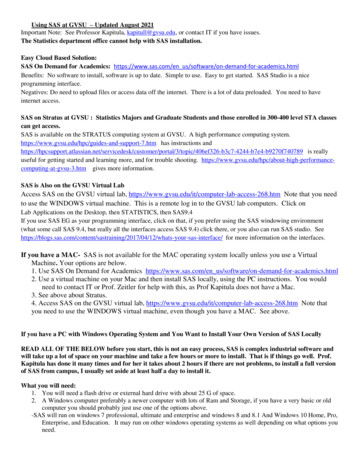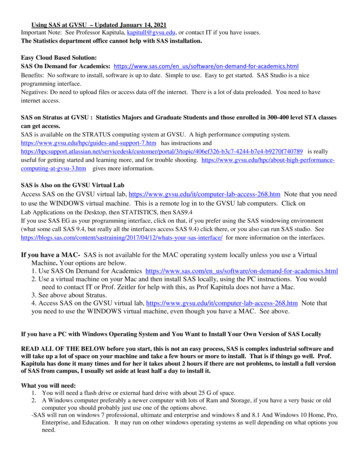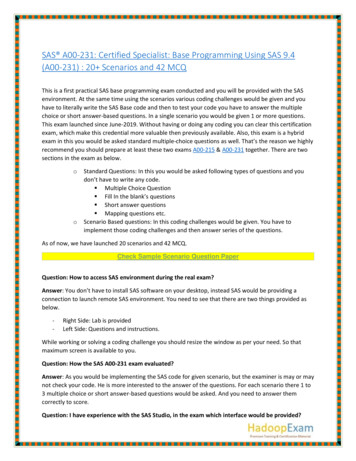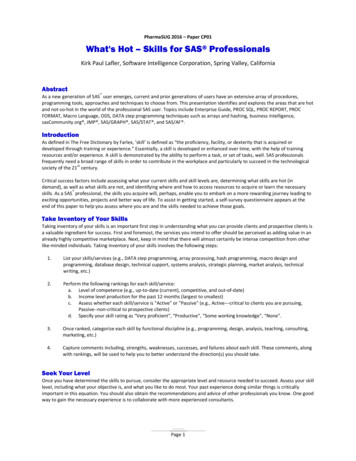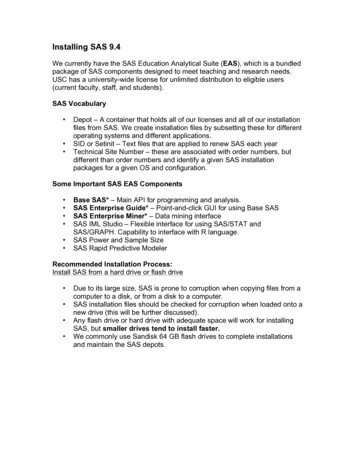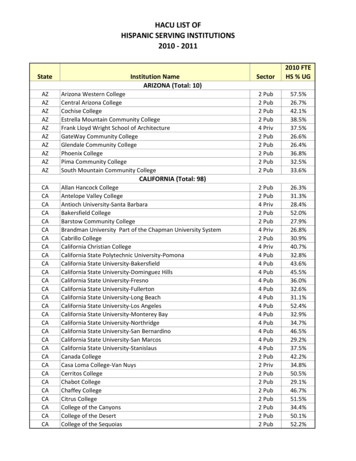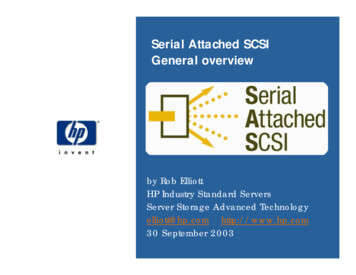
Transcription
Serial Attached SCSIGeneral overviewby Rob ElliottHP Industry Standard ServersServer Storage Advanced Technologyelliott@hp.com http://www.hp.com30 September 2003
Notice Theseslides are freely distributed by HP through theSCSI Trade Association (http://www.scsita.org) STA members are welcome to borrow any number of theslides (in whole or in part) for other presentations,provided credit is given to the SCSI Trade Associationand HP This compilation is 2003 Hewlett-Packard Corporation9/30/2003SAS general overviewpage 2
SCSI – Small Computer System Interface9/30/2003SAS general overviewpage 3
History of parallel SCSIInterconnect Standard Year1979SASIKey featuresShugart AssociatesAsynchronous,1986 2 MB/secSCSI-1SCSI-1narrow1989 10 MB/sec Synchronous, wideSCSI-2SCSI-2Split command sets, transport protocols, and physicalSCSI-3interfaces into separate standards1992 20 MB/secFast-Wide SPI/SIPFast-201995 40 MB/secUltraannex1997 80 MB/secLVDUltra 2 SPI-29/30/2003Ultra 3SPI-3Ultra 320SPI-4Speed1999 160 MB/secDT, CRCPaced, Packetized,2001 320 MB/secQASSAS general overviewpage 4
SCSI standards structureWith SCSI-3, SCSI has been broken into multiplestandards (and has dropped the -3 moniker) Allows support for additional SCSI transport protocols 9/30/2003SAS general overviewpage 5
SCSI architecture roadmap (comprehensive)9/30/2003SAS general overviewpage 6
History of serial SCSI Therehave been many serial SCSI protocolsInterconnect Standard Year Typical speed Key featuresFibre ChannelSerial StorageArchitecture(SSA)Serial StorageArchitecture(SSA)FireWire(IEEE 1394)Fibre SA-TL1, 1996SSA-PL1SSA-S3P,SSA-TL2, 1997SSA-PL2100 MB/secOptical20 MB/secIBM only vendor40 MB/secIBM only vendorSBP-2199850 MB/secFCP-2SRPiSCSI2002 200 MB/sec2002 250 MB/sec4x, 12x too2003 100 MB/sec Gigabit EthernetSAS general overviewpage 7
ATA – AT Attachment9/30/2003SAS general overviewpage 8
History of parallel ATAGeneration Standard Year1986IDEEIDESpeedKey featuresPre-standardPIO modes 0-2,ATA1994multiword DMA 0PIO modes 3-4,ATA-21996 16 MB/sec multiword DMA modes1-2, LBAs1997 16 MB/secSMARTATA-3Ultra DMA modes 0ATA/ATAPI-4 1998 33 MB/sec2, CRC, overlap,queuing, 80-wireUltra DMAATA/ATAPI-5 2000 66 MB/sec Ultra DMA mode 3-466Ultra DMA mode 5,Ultra DMAATA/ATAPI-6 2002 100 MB/sec48-bit LBA100Ultra DMAATA/ATAPI-7 2003 133 MB/sec Ultra DMA mode 61339/30/2003SAS general overviewpage 9
ATA standards architecture9/30/2003SAS general overviewpage 10
History of serial ATAGeneration Standard YearSpeedSerial ATA ATA/ATAPI-7 2002 150 MB/secKey featuresSerial ATA II ATA/ATAPI-8? 2003? 300 MB/sec Enhanced queuingSerial ATA III ATA/ATAPI-9?9/30/2003?600 MB/secSAS general overviewpage 11
Distinct markets Different classes of disk drivesCharacteristicMobile3600, 4200,5400 rpm12 – 14 msDesktopEnterprise5400, 7200 rpm10K, 15K rpm8.9 – 9.5 ms3.2 – 7.4 msN/A79 – 136146 - 3662 MB2 – 8 MBCapacity10 – 80 GB40 – 250 GBReliabilityPowerCost300 K hr MTBF2.5 W 73 – 160500 K hr MTBF10 W 75 – 240InterfacesATA/66, ATA/100ATA/100,ATA/1332 – 8 MB18, 36, 72, 144,180 GB1.2 M hr MTBF15 W 160 – 1400Ultra 160 SCSI,Ultra 320 SCSI,FCrpmSeek timePerformanceas file server*Write cache* Benchmark of many drives on http://www.storagereview.com9/30/2003SAS general overviewNote: As of mid 2002page 12
Bringing SCSI and ATA together 9/30/2003SAS general overviewpage 13
Serial Attached SCSI (SAS) SerialAttached SCSI (SAS) supports both SCSIand ATA Three transport protocols–Serial SCSI Protocol (SSP) Supports SAS (SCSI) disk drives, tape drives, etc.–Serial ATA Tunneling Protocol (STP) Supports Serial ATA disk drives–Serial Management Protocol (SMP) Supports SAS expanders9/30/2003SAS general overviewpage 14
Positioning SATA, SAS, and FCDesktop PC / WorkstationMainstream Servers / DirectAttached StorageStorage Area NetworkAdd a SAS HBAfor high-endworkstationsPC ChipsetSASHBAServer chipset with SAS support, SAS HBAcard, or SAS RAID card to drives or JBODsFC HBA to externalstorageConfigurationFlexibility & SimplicityHDDTypeOne host design accommodatesSATA forLow Cost Bulk StorageorSAS for& Reliability inSAS PerformanceMission Critical AppsSATADesktop-class disk drives(single port)Enterprise-class disk drives Enterprise-class disk drives(dual port)(single or dual port)Compatible physical layerbetween SATA and SATA9/30/2003FCSimilar HDD ASIC and firmware designbetween SAS and FCSAS general overviewpage 15
Direct attach and expander attachDirect attach Number of drives limited to number of portsin the HBAExpander attach More drives than HBA portsSAS HBA (initiator)SASphysicallinkSATAphysicallinksSTP (Serial ATATunnelingProtocol) usedover SASphysical linkswhencommunicatingwith SATAdrives throughexpandersSAS HBA(initiator)SAS ATADriveSSP (Serial SCSIProtocol) used tocommunicate withSAS drives9/30/2003SATADriveSASDriveSATA (Serial ATA)used tocommunicate withSATA drives overSATA physical linksSASphysicallinksSAS general callinksSATASATADriveSATADriveDrivespage 16
Serial Attached SCSI timelineMay 2002SerialAttachedSCSIintroducedto T10Serial Attached SCSIProductDesign2002Serial Attached SCSITest andIntegration2003November 2002Serial Attached SCSIstandard to T10letter ballotSerial Attached SCSIProductAvailability2004SAS-1.1 for bug fixesSAS-2 for 6.0 GbpsMay 2003Serial Attached SCSIto ANSI public reviewSeptember 2003Serial Attached SCSIto ANSI publication9/30/2003SAS general overview1Q03ASIC testing4Q03Emulator testingpage 17
SCSI Trade Association erialAttachedSAS 600Serial SIUltra320Ultra 3202002 2003 2004 2005 2006 2007 2008 2009 2010 2011 20129/30/2003SAS general overviewpage 18
SAS press releases (part 1) 11/26/2001 Compaq/IBM/LSI Logic/Maxtor/Seagate– 2/4/2002 STA–SCSI Trade Association and Serial Attached SCSI Working Group Announce Agreement–INCITS Technical Committee T10 Accepts Proposal to Begin Work on Serial AttachedSCSI Standard5/6/2002 STA6/12/2002 Dell/HP/Intel– Industry Leaders Team to Form Serial Attached SCSI Working Group to Address NextGeneration Interconnect NeedsIndustry Leaders Collaborate on New Choices for Next-Generation Serial Architecturesfor Server Storage1/9/2003 STA–Serial Attached SCSI Letter Ballot Released by T10–STA and SATA II Working Group Agree to Collaborate on Specification Alignment–Seagate Demonstrates Industry's First Serial Attached SCSI Storage Solutions with HP–LSI Logic and Leading Hard Disk Drive Manufacturers Initiate Serial Attached SCSIProduct Planning1/20/2003 STA1/20/2003 HP/Seagate1/20/2003 LSI Logic9/30/2003SAS general overviewpage 19
SAS press releases (part 2) 3/18/2003 Adaptec–Adaptec First Host Bus Adapter Provider to Transmit Serial Attached SCSI Protocol Packet–Hitachi and LSI Logic to Accelerate Delivery of Serial Attached SCSI–Emulex and Intel to Develop first Storage Processors for Serial ATA, SAS and FibreChannel within a Single Architecture3/25/2003 Hitachi/LSI Logic4/15/2003 Emulex/Intel4/21/2003 Adaptec/Fujitsu/Hitachi/Maxtor/Seagate– Adaptec Teams with Fujitsu, Hitachi, Maxtor and Seagate to Bring First Serial AttachedSCSI Solutions to Market4/29/2003 LSI Logic/Seagate/Tabernus–Tabernus, LSI Logic and Seagate Technology Work Together for Serial Attached SCSI–LSI Logic First To Demonstrate Serial Attached SCSI Initiator-to-Target Functionality withFull Read/Write Validation5/9/2003 LSI Logic6/11/2003 Adaptec/Maxtor/Tabernus–9/30/2003Tabernus, Adaptec, and Maxtor Work to Ensure Compatibility of Serial Attached SCSISolutions, Speed Time to MarketSAS general overviewpage 20
SAS press releases (part 3) 6/16/2003 Adaptec/HP/Seagate– Adaptec, HP and Seagate Technology Team to Debut Compatibility of Serial AttachedSCSI and Serial ATA at CeBIT America6/24/2003 LSI Logic/Maxtor–LSI Logic and Maxtor Extend Testing of Serial Attached SCSI Prototypes–LSI Logic Teams With Seagate to Drive Serial Attached SCSI Interoperability–Maxtor Demonstrates Early Success with Serial Attached SCSI Interface6/26/2003 LSI/Seagate6/30/2003 Maxtorto be continued 9/30/2003SAS general overviewpage 21
Serial Attached SCSI standard9/30/2003SAS general overviewpage 22
SAS standard layering9/30/2003SAS general overviewpage 23
Key features of SAS by layer Physical layer – connectors Architecture - Expanders and topologies Phy layer – OOB and speed negotiation Link layer - connections Transport layer – frames Wrap Up9/30/2003SAS general overviewpage 24
Physical layer9/30/2003SAS general overviewpage 25
SATA cables and connectorsSATA 1.0 wasdefined for internaluse only (e.g. insidea PC) 1 m internal cable No externalconnectors/cables Power cable receptacleconnectorInternal cabledenvironmentPowersupplySATAdeviceSATA hostSignal host plugconnectorSignal cable receptacleconnectorsInternal backplaneenvironmentSATA hostHost receptacleconnector9/30/2003SAS general overviewDevice plug connectorSATAdeviceDevice plug connectorpage 26
SATA device connectorDevice connector sizes and locationsAppearance of Serial ATA Connectors(Drawing courtesy of Molex)SerialDevice plugconnector2.5"power signalSerial ATAsignalconnectorSerial ATA(pin S1)powerconnector(pin P1)Serialpower signal3.5”Legacy Power(vendor specific)(5.25” form factor also defined fordevices like tape drives and DVDs)in comparison ParallelHost receptacleconnector9/30/2003SAS general overviewparallel ATA signals3.5”4-pin powerpage 27
SAS cables and connectors - internalSimilarly, SASdefines internalenvironments Backplanes supporttwo physical links Cables mainlysupport one phy(for debug, twophysical link cablesmight be useful) HP proposing 4xinternal connectorfor SAS-1.1 Single port internal cabled environmentSASinitiatordevice orexpanderdeviceSATA-style signalcable receptacleSAS targetdeviceSecondary portPrimary portSAS internal cableSAS plug connectorreceptacle connector(2 physical links plus power)(1 physical link plus power)SATA-stylehost plugconnectorInternal backplaneenvironmentPower / LED connection vendor-specificSASinitiatordevice orexpanderdeviceSAS backplane receptacle connector(2 physical links plus power)9/30/2003Power / LED cableconnectionvendor-specificSAS general overviewSAS targetdeviceSAS plug connector(2 physical links plus power)page 28
SAS plug and backplane receptacle connectorsSAS Port 1SAS primary physical linkSAS Backplane ConnectorSAS backplane receptacleconnectorPowerPowerSAS Port 2SAS(onsecondaryphysical linkbackside)(on backside)PowerPowerSATA/SATA/SASSAS Port 2 primarySAS Port 1physical linkPowerPowerSATA PortSATA physical linkSAS secondary physical linkNote: SATA backplane connectorsNote: SATA backplane connectorsWill NOT accept SAS drivesWill NOT accept SAS drives9/30/2003SAS general overviewpage 29
SAS cables and connectors - external SAS defines an external (box-to-box) environment using InfiniBand4x connectors and cablesExternal cabledenvironmentSAS external cable plugconnectors(4 physical links)SAS deviceor expanderdeviceSAS external receptacleconnector (4 physical links)SAS deviceor expanderdeviceSAS external cable(1 to 4 physical links)SAS external receptacleconnector (4 physical links)(SAS external cable connects the Tx signal pins tothe Rx signal pins on each physical link)9/30/2003SAS general overviewpage 30
SAS external receptacle connector (picture courtesy FCI/Berg)9/30/2003SAS general overviewpage 31
Architecture9/30/2003SAS general overviewpage 32
Physical links and phys Aphy contains one transceiver A physical link attaches two phys togetherPhyPhyTransceivertransmitterPhysical linkDifferential signal pairTransceiverreceiver-Signal SignalDifferential signal pairreceivertransmitter-Signal Signal9/30/2003SAS general overviewpage 33
Differential signalingPositive signal(single-ended)(non-inverted)1500 mVCommon modevoltage (thelevel is not veryimportant)1200 mV900 mV0VNegative signal(single-ended)(inverted)1010111500 mV1200 mVCommon modevoltage900 mV0VDifferential signal01011600 mVpositive - negative1500-900 600 mV0Vor900-1500 -600 mV-600 mV9/30/20031Differentialsignal isimmune tonoise commonto both singleended signals101SAS general overview011page 34
Physical link rate Each direction runs 1.5 Gbps or 3.0 Gbps (150 MB/sec or 300MB/sec)–Both directions use the same physical link rateDual simplex (full duplex) operation – 600 MB/sec total bandwidth Example: peak bandwidth needs of an HBA with 8 phys –9/30/20032400 MB/sec half duplex, 4800 MB/sec full duplexSAS general overviewpage 35
SAS devices and ports SASdevices containNarrow portports Ports contain phys Ports are virtualconstructs–DeviceDeviceNarrow portphyphyphyphyDeviceWide portGroups of phy with thesame SAS address,attached to anothergroup of phys with thesame SAS addressphyWide portphyDevicephyWide portphyphyWide portphyEach horizontal line represents a differential signal pair9/30/2003SAS general overviewpage 36
SAS addressEach SAS port and expander device has a worldwide unique 64bit SAS address Same namespace as the Fibre Channel Port Name Byte\Bit01276543210NAA (5h)IEEE Company ID (24 bits)3456Vendor-Specific Identifier (40 bits)79/30/2003SAS general overviewpage 37
End devices Enddevice is a SAS device that is not an expanderdevice Sample end devices–HBA – 8 phys One SAS address for all 8 phys– Potentially all one (very) wide port One SAS address for 4 phys, another SAS address for 4 phys– Guarantees at least two ports– Good match for 4-wide connectors Eight SAS addresses–Disk drive - 2 phys Separate SAS address for each phy– Guarantees two ports– Never a wide port9/30/2003SAS general overviewpage 38
Expander devicesExpander devicecontains expanderports May contain SASdevices too (e.g. forenclosuremanagement) Each expanderdevice has a SASaddress Each expander phyhas a phy identifierunique within thatexpander device ExpanderdeviceSMPtargetportExpander port(internal/optional)with virtualphysSAS portExpander al)Either SSP, STP and SMPSAS initiator ports, SAS target ports, orexpander ports9/30/2003SAS device(internal/optional)SAS general overviewExpander port(narrow port)ExpanderphySATASATA deviceportpage 39
Expander device types – edge vs. fanoutExpander deviceSAS addressAn expander device is an edge expander device or afanout expander deviceEdge expander device Edge––expander deviceAlways part of an “edge expander device set”May perform subtractive routing Fanout––Fanout expander deviceexpander deviceNever does subtractive routingUsually supports larger tables for table routing Topologies9/30/2003described laterSAS general overviewpage 40
DomainsA s An ATAdomaincontains aSATA hostand aSATAdevice Service deliverysubsystemwith port(s)SAS ortATA domain(informative)Note: When expander devices are present, SAS target ports may belocated in SAS devices contained in expander devices.SAS general overviewpage 41
SAS domain bridged to ATA Pinitiatorport(s)STPSMPinitiatorport(s)SMPService deliverysubsystemwith (s)9/30/2003STPSTPtargetport(s)SAS domainSTPSTP/SATAbridge(s)SATAATA deviceportATA domain(informative)SMPSMPtargetport(s)SAS general overviewpage 42
SAS devices in multiple SAS domains9/30/2003SAS general overviewpage 43
Edge expander device set Setof edge expander devices 128 SAS addresses per set Typically bounded by a subtractive port (to a fanoutexpander device, or to another edge expander deviceset) Edge expander devices uses table routing and directrouting “downstream” and subtractive routing“upstream” Wide links between expanders are allowed No loops9/30/2003SAS general overviewpage 44
Expander topologies Maximumof one fanout expander device in a SASdomain If no fanout expander, maximum of two edge expanderdevice sets (attached via subtractive decode ports) End devices may be attached at any level––Directly to fanout expander deviceAny level edge expander device Widelinks possible between any two devices No loops No multiple paths9/30/2003SAS general overviewpage 45
Edge expander device set and fanout expanderdeviceOne fanoutexpanderdeviceFanout expander deviceEdgeexpanderdevicesetAny of thephysical linkscould be wideEdgeexpanderdeviceEdgeexpanderdeviceEnd deviceEdgeexpanderdevicesetEdgeexpanderdeviceEnd deviceEdge expander deviceEnd deviceMaximumof 128SASaddressesperedgeexpanderdevicesetEnd device128 edge expander device sets9/30/2003SAS general overviewpage 46
Two edge expander device sets9/30/2003SAS general overviewpage 47
Expander routing attributes and methodsEach expander phy has an expander routing attribute The attribute determines the routing methods the expander useswith each phy Routing attribute When attached toEnd deviceDirectExpander deviceTableEnd deviceExpander deviceSubtractiveEnd deviceRouting method usedDirectTable DirectDirectSubtractive ( Direct)DirectDirect route requests to the attached SAS port through this phy Table route requests that match in routing table through this phy Subtractive route unresolved requests through this phy 9/30/2003SAS general overviewpage 48
Expander route table contentsPhy identifierA phy identifier for each expander phyof the expander device.Expander route table012.NN number of phys - 101Expander route entry2.Includes:! Routed SAS address! Enable/disable bitMExpander route indexAn expander route index for eachexpander route entry.M expander route indexes - 19/30/2003SAS general overviewpage 49
Connections Connection temporary association between an initiatorphy and a target phy–Source phy transmits an OPEN address frame–Expanders route it to a matching destination phyDestination phy replies with an OPEN ACCEPT primitiveConnection is establishedBoth sides exchange CLOSE primitives to close––– Contains a destination SAS address Connectionsare addressed to ports but established phy-to-phy N-wide ports may establish N connections at a time (toup to N other ports) Wide ports may establish multiple connections to otherwide ports simultaneously9/30/2003SAS general overviewpage 50
Connection examplesFanout expander device2-wide link4-wide linkEdgeEdgeexpanderexpanderdevicedeviceset2-wide link1-wide linkEdgeEdgeexpanderexpanderThe greendevicedeviceEdgeexpanderdevicesetEdge expander devicerequest isblockeduntil the redconnectionfinishesEnd device9/30/2003End deviceSAS general overviewEnd deviceEnd devicepage 51
Connection rules Connectionsare addressed to SAS ports but areestablished from phy to phy Wide ports may establish multiple connections at a time(to up to one per phy) to different destinations Wide ports may establish multiple connections to otherwide ports simultaneously (wide initiator port to widetarget port)––9/30/2003SAS disk drives will offer two narrow portsOnly HBAs and RAID controllers will offer wide portsSAS general overviewpage 52
Rate matching (connection rate)Lets 1.5 Gbps and3.0 Gbps SAS portscommunicate– Especially 3.0Gbps initiatorsand 1.5 GbpsSATA drives On faster physicallinks, insert ALIGNprimitives to slowdown the effectivedata rate to matchthe slowest physicallink in theconnectionPhysical link A3,0 Gbpsnegotiated physicallink rate EnddevicePhy(insertsALIGNs)Physical link C3,0 Gbpsnegotiated physicallink rateExpander deviceExpander vesALIGNs)(insertsALIGNs)1,5 Gbpsconnectionrate1,5 Gbpsconnectionrate1,5 GbpsconnectionrateSample dwords on physical links (from left to right) during a 1,5 Gbps connection:TimePhysicallink APhysicallink BPhysicallink C9/30/2003Physical link B1,5 Gbpsnegotiated physicallink rateALIGNdword 0ALIGNdworddworddword 1ALIGNdword 0ALIGNSAS general overviewdwordALIGNdword 2ALIGNdword 1dword 0ALIGNdworddword 2dword 1ALIGNpage 53
Phy layer9/30/2003SAS general overviewpage 54
Encoding 8b10bcoding converts 8-bit bytes into 10-bitdata characters for transmission on the wire8 bits Reasons––––Clock recoveryDC balanceSpecial charactersError detection Mapping––010 bits0255done with two simple logic blocks5b6b and 3b4bFull table in SAS and SATA Invented Used byby IBM in 1983Fibre Channel, Gigabit Ethernet,1394b, and many other standards9/30/2003SAS general overview1023page 55
Dwords Byte 8 bits (xxh) Character 10 bits (Dxx.y or Kxx.y) Dword 4 characters (or 4 bytes, depending oncontext)––––40 bits on the wireUsually represents 32 bits of dataA dword may flip disparity or leave it the sameA dword is either a data dword, a primitive, or an invaliddwordfirst second third fourthchar char char char9/30/2003SAS general overviewpage 56
Primitives 1control character and 3 data characters–First character is K28.5 (for SAS primitives), K28.3 (forSATA primitives), or K28.6 (special SATA error primitive) K28.6 primitive serves as an invalid dword for SATA–Last three characters are data charactersEndianness does not matter both SAS and SATA primitives always have the controlcharacter first on the wire–first second third fourthK28.5 Dxx.y Dxx.y Dxx.yK28.3 Dxx.y Dxx.y Dxx.yK28.6 Dxx.y Dxx.y Dxx.y9/30/2003SAS general overviewpage 57
OOB signals OOB–signal is a pattern of idle times and burst timesIdle time (and negation time) Differential 0 V (Positive signal negative signal) No transitions (DC idle)–Burst time Transmitted as a burst of ALIGN(0) primitives Received as presence of edges (whether they are valid ALIGNsis irrelevant) Designedto be detectable by analog squelch detectionlogic Length of idle time distinguishes between OOB signals–9/30/2003COMINIT, COMWAKE, and COMSASSAS general overviewpage 58
SAS OOB sequenceTransmit and receive COMINITTransmit COMSAS– If COMSAS received, physical link is SAS to SAS– If COMSAS is not received, physical link is SAS to SATA There are a few hot-plug situations where COMINIT leadsdirectly to COMSAS; this is allowed 9/30/2003SAS general overviewpage 59
SAS to SATA OOB sequenceIf COMSAS is not received, physical link is SAS to SATA SAS OOB sequence morphs into the SATA OOB sequence Since the SAS device drives COMWAKE, it looks like a SATAhost Only supports SATA device not SATA host 9/30/2003SAS general overviewpage 60
SAS speed negotiation sequence Slow-to-fastBoth phys runsame set ofspeednegotiationwindows1.5, then 3.0,then 6.0 (ifneeded), etc.until they find:– a supportedrate; then– a (faster) nonsupported rateLast windowreturns to thehighestsupported ratedetected9/30/2003SAS general overviewpage 61
Link layer9/30/2003SAS general overviewpage 62
Clock skew management Slow down the transmitter by including dwords that can be deleted– ALIGN (and NOTIFY for SAS) primitives stuck in– Throttles the transmitter to be slower than the slowest receiver SATA (and SAS STP) requires 2 per 256 dwords (0.7812%)– Must always appear in pairs SAS requires 1 per 2048 dwords (0.0488%)Receiver throws away incoming ALIGNs (and NOTIFYs for SAS)–transmitter dword e 9/30/2003dword fdword ereceiverALIGNdword fSAS general overviewdword gdword gdword hdword idword hpage 63
Connections Establishedbetween a SAS initiator phy and a SAStarget phy Three types of connections–––SSP (Serial SCSI protocol)SMP (Serial management protocol)STP (Serial ATA Tunneling protocol) Basic–––sequence1. Transmit OPEN address frame2. Receive AIP (arbitration in progress) primitives ifexpanders are involved3. Receive final result OPEN ACCEPT primitive – connection established OPEN REJECT primitive – rejected, go back to idle SATA9/30/2003has no concept of connectionsSAS general overviewpage 64
Connection – basic sequenceSOAFOPENaddress 8 data dwordsEOAFframeidledwords idle dwords 9/30/2003SAS general overviewAIPidle dwordsAIPidle dwordsAIPidle dwords OPEN ACCEPTor OPEN REJECTpage 65
Arbitration fairness and deadlocks SASimplements a Least Recently Used (LRU) arbitrationfairness scheme––Each OPEN address frame includes the age of a requestIn case of ties, SAS addresses are used to pick the highestpriority SASimplements deadlock detection and recovery usingPartial Pathway timers––9/30/2003When expanders detect a hang, one request is backed offto break the likely deadlockSAS addresses are eventually used to decide which requestis the lowest priority and gets backed offSAS general overviewpage 66
Closing a connection Exchange CLOSEprimitive sequencesend-to-end to close aconnectionSSP and SMP requiretraffic be stopped first– CLOSE ignored bySAS phy statemachines if not atthe correct timeSTP connectionshould be idle beforeclosing– Not enforced by SLstate machineExpanders alwayshonor CLOSEregardless ofconnection state9/30/2003SAS general overviewpage 67
SSP overview Inside an SSP connection Phys exchange SSP frames––SSP frame SOF primitive, data dwords, EOF primitiveEach frame results in an ACK or NAK primitive Credit-based–flow controlPermission to send a frame must be granted with RRDYprimitives Fullduplex–SSP frames can be sent in both directions simultaneouslyIndependent credit for each direction–(so can ALIGNs and NOTIFYs)– ACK,NAK, and RRDY primitives may be interjectedamong frame dwords9/30/2003SAS general overviewpage 68
SSP interlocked frames example Showing frames only in one directionSendframeWait forACK orNAKSendframeWait forACK orNAK9/30/2003Interlocked frameEOFidle dwords ACK or NAKidle dwords SOFInterlocked frameEOFidle dwords ACK or NAKSAS general overviewpage 69
SSP non-interlocked frames example Showing frames in one directionNon-interlocked frameEOF, SOF, non-interlocked frame1EOF, SOF, non-interlocked frame2EOF, SOF, non-interlocked frame3EOFidle dwords142349/30/2003SAS general overviewACK or NAK, idle dwordsACK or NAK, idle dwordsACK or NAK, idle dwordsACK or NAK, idle dwordspage 70
SMP overview Only–an initiator can open an SMP connectionTarget not allowed to open an initiator Insidean SMP connection Two SMP frames are transferred–––9/30/2003SMP frame SOF primitive, data dwords, EOF primitive1. Initiator transmits one SMP REQUEST frame to target2. Target transmits one SMP RESPONSE frame to initiatorSAS general overviewpage 71
SMP exampleSMP initiator phySMP target phyOPEN ACCEPTSendrequestframeSOFSMP REQUEST frameEOFidle dwords SendresponseframeSOFSMP RESPONSE frameEOFidle dwords (optional)CLOSECLOSE9/30/2003SAS general overviewpage 72
STP and SATA overview InSATA, SATA host and SATA device just communicatedirectly – no connections In SAS, once an STP connection is open, STP initiatorand STP target communicate as if they were SATA hostand SATA device directly attached on a physical link–Extra latency introduced as dwords flow through expanders Half–– duplexSATA never transmit frames in both directions at one timeUsually the frame goes one way and R IP primitives go theother wayNote: SAS prefixes the SATA primitive names with “SATA ”––9/30/2003SATA SOF (used in STP) is different than SOF (used in SSP)In this presentation, prefix not always usedSAS general overviewpage 73
SATA basic frame transmissionIdleRequestpermissionSATA SYNCSATA X RDYSATA SYNCIdleSATA R RDYSendframeWait forterminationIdleGrantpermissionSATA SOFData dwordsSATA EOFSATA WTRMSATA R IPSATA R OK or SATA R ERRAcknowledgeframe receiptSATA SYNCSATA SYNC9/30/2003Receipt inprogressSAS general overviewIdlepage 74
Transport layer9/30/2003SAS general overviewpage 75
SSP framesOne common SSPframe format– Frame header: 24bytes– Information Unit: 0to 1024 bytes– Fill bytes: 0 to 2bytes– CRC: 4 bytes Frame format isbased on FibreChannel 9/30/2003ByteField(s)0Frame Type1 to 3Hashed Destination SAS address4Reserved5 to 7Hashed Source SAS address8 to 9Reserved10Reserved11ReservedRetransmitNumber of FillBytes12 to 15Reserved16 to 17Tag18 to19Target Port Transfer Tag20 to 23Data Offset24 to mInformation Unitm to (n-3)Fill bytes, if needed(n-3) to nCRCSAS general overviewRsvdpage 76
SSP frame types Information Units are nearly identical to Fibre ChannelProtocol (FCP)– Separate TASK frame is new to SASInformationCommand Unit field DirectionDescriptionsizeCOMMAND 28 to 284 I to T Send a commandTASKI to T Send a task management function28XFER RDYT to I Request write data12I to T or Write data (I to T) or read data (TDATA1 to 1024T to I to I)Send SCSI status (for commands) or24 toRESPONSET to I task management response (for task1024management functions)9/30/2003SAS general overviewpage 77
SSP task management frame sequenceSSP initiator portSend TaskManagementRequest ()Received TaskManagementFunctionExecuted ()SSP target portTASK frameRESPONSE frametime9/30/2003TaskManagementRequestReceived ()TaskManagementFunctionExecuted ()timeSAS general overviewpage 78
SSP non-data command sequence9/30/2003SAS general overviewpage 79
SSP write command sequenceSSP initiator portSend SCSICommand ()SSP target portCOMMAND frameXFER RDY frameSSPinitiator portreplies toXFER RDYwith one ormore DATAIUsCommandCompleteReceived ()DATA frameRESPONSE frametime9/30/2003SCSI Command Received ()SSP target portsendsXFER RDYframes andreceives DATAframes until allwrite data hasData Out Received ()beentransferredReceive Data Out ()Send Command Complete ()timeSAS general overviewpage 80
SSP read command sequenceSSP initiator portS
Serial Attached SCSI Test and Integration Serial Attached SCSI Product Availability November 2002 Serial Attached SCSI standard to T10 letter ballot May 2003 Serial Attached SCSI to ANSI public review Serial Attached SCSI Product Design SAS-1.1 for bug fixes SAS-2 for 6.0 Gbps September 2003 Serial Attached SCSI to ANSI publication 4Q03 .
